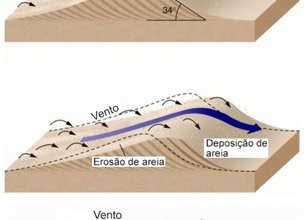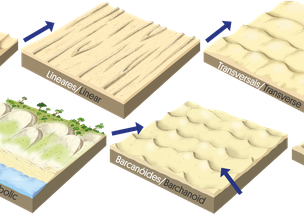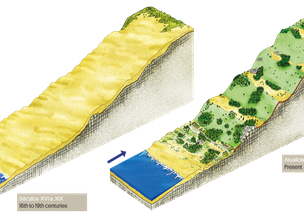Formation precesses and types of wind dunes
The formation of dunes by the wind
Dunes are landforms that develop from the movement of sedimentary particles driven by a fluid, usually air or water (esq. A).
The transport of sediments leads to the formation of rhythmic elevations with two faces. The windward face is less inclined and the opposite face is more inclined. The crest of the dune separates its two faces. Sediments are moved from the windward face to the opposite face. This continued action results in the dune migrating in the same direction of the prevailing wind. This migration continues as long as: i) the wind continues to blow; ii) there is enough supply of sand and; iii) there are no obstacles in the way the dune is migrating.
Types of dunes
Regarding morphology, dunes may be classified into six major groups, based on the shape, number of faces, and wind direction (esq. B).
Transverse dunes form when there is plenty of sand. Viewed from above, these dunes have parallel or slightly curved ridges and align perpendicular to the prevailing wind direction. There is a close relationship between the height of the dune, its width and the space between ridges. The transverse dune sediments give rise to a cross bedding that is preserved at the same time as the dune migrates. Transverse dunes account for about 40% of existing dunes globally.
Linear dunes are formed in areas with limited sediment supply but strong wind. The elongated parts of these dunes are parallel to the wind direction. These dunes are usually less than 4 meters high, but can extend for several kilometres. In the wide deserts, for example, these dunes can reach 100m in height and 120km long.
Barchan dunes are formed in the absence of vegetation, with dominant wind with slight variations and limited sediment input. Barcans occur as isolated, crescent-shaped dunes with a well-marked concave face and horn-shaped tips that develop to leeward. If wind conditions are relatively constant, they can migrate long distances without significant changes in shape. Most barcans have a convex profile and their height is typically 1/10 of their width. If the sediment input increases progressively, the dunes barcans can progressively form barcanoid dunes or even transverse dunes. As in the transverse dunes, barcanoid dunes also give rise to cross-bedding. Barcans represent only a small percentage of dunes globally.
Parabolic dunes are common in most low coastal areas and sandy environments in semi-arid environments. Parabolic dunes are characterized by the U-shape in which the ends or tails of the dune that lie behind are parallel and partially overgrown. The most frontal part, also called the “nose” of the dune, advances further than these points. The conditions of formation of these dunes are not yet fully understood, but seem to be associated with the presence of moderately developed vegetation, a strong and predominantly unidirectional wind regime, and a reasonable sediment input. The parabolic dunes are reminiscent of the barcans dunes but with the ends pointing in the opposite direction. The dune can be anchored by vegetation.
Star dunes are characterized by their considerable size, in the order of hectares, pyramidal shape and radiant and curved tips or arms. The basal faces of the star dunes consist of a smooth and wide profile. They are the largest dunes in many deserts and can reach heights of over 300 meters. They usually have a higher volume of sand than other types of dune. These dunes are associated with locations with high sediment availability and varying wind directions, especially at the time of transport. They have a central peak with a pyramidal shape, from which radially extend several tips or arms, the whole having several faces.
In what concerns its mobility, dunes can be stationary or migratory. In stationary dunes, the sand settles in successive layers that follow the exposed profile of the dune, creating a stratified internal structure. Although, downwind of the dune, strong wind-generated turbulence may occur, the sand particles remain attached to the windward strata, which tends to block the movement of the dune. Increasing moisture, internal obstacles (rocky outcrops, logs, etc.), or vegetation may affect dune mobility.
In the migratory dunes, sediments move downwind and precipitate downwind, leading to dune migration. The intensity of this movement varies, depending on the intensity of the wind, the availability of sediment, the existence of obstacles, among others. Dune migration can cause problems, such as infilling of water bodies or burial of agricultural fields or built structures.
Fossil dunes are consolidated dunes or paleodunes, and represent a development stage after the dune formation and mobility. This process may be short, corresponding to the consolidation of dunes due to absence of wind or water or by protection of the dune sediment by vegetation. In more advanced stages, which may last several thousand years, dune consolidation may occur, but maintaining the respective sedimentary structures. Such consolidation may be due to the formation of a carbonate cement resulting, for example, from the dissolution of fragments of shell constituents of the sand or from the percolation of carbonates carried by water.
In Galeão hill there are four steps at 50 m (Vila Fria step), 75 m (Ola step), 100 m (Faro de Anha step) and 160 m high (Além do Rio step). Between the 16th and 19th centuries, a colder climate and the absence of vegetation allowed the sand to spread until the top of Galeão hill (esq. C).
The formation of dunes by the wind
Dunes are landforms that develop from the movement of sedimentary particles driven by a fluid, usually air or water (esq. A).
The transport of sediments leads to the formation of rhythmic elevations with two faces. The windward face is less inclined and the opposite face is more inclined. The crest of the dune separates its two faces. Sediments are moved from the windward face to the opposite face. This continued action results in the dune migrating in the same direction of the prevailing wind. This migration continues as long as: i) the wind continues to blow; ii) there is enough supply of sand and; iii) there are no obstacles in the way the dune is migrating.
Types of dunes
Regarding morphology, dunes may be classified into six major groups, based on the shape, number of faces, and wind direction (esq. B).
Transverse dunes form when there is plenty of sand. Viewed from above, these dunes have parallel or slightly curved ridges and align perpendicular to the prevailing wind direction. There is a close relationship between the height of the dune, its width and the space between ridges. The transverse dune sediments give rise to a cross bedding that is preserved at the same time as the dune migrates. Transverse dunes account for about 40% of existing dunes globally.
Linear dunes are formed in areas with limited sediment supply but strong wind. The elongated parts of these dunes are parallel to the wind direction. These dunes are usually less than 4 meters high, but can extend for several kilometres. In the wide deserts, for example, these dunes can reach 100m in height and 120km long.
Barchan dunes are formed in the absence of vegetation, with dominant wind with slight variations and limited sediment input. Barcans occur as isolated, crescent-shaped dunes with a well-marked concave face and horn-shaped tips that develop to leeward. If wind conditions are relatively constant, they can migrate long distances without significant changes in shape. Most barcans have a convex profile and their height is typically 1/10 of their width. If the sediment input increases progressively, the dunes barcans can progressively form barcanoid dunes or even transverse dunes. As in the transverse dunes, barcanoid dunes also give rise to cross-bedding. Barcans represent only a small percentage of dunes globally.
Parabolic dunes are common in most low coastal areas and sandy environments in semi-arid environments. Parabolic dunes are characterized by the U-shape in which the ends or tails of the dune that lie behind are parallel and partially overgrown. The most frontal part, also called the “nose” of the dune, advances further than these points. The conditions of formation of these dunes are not yet fully understood, but seem to be associated with the presence of moderately developed vegetation, a strong and predominantly unidirectional wind regime, and a reasonable sediment input. The parabolic dunes are reminiscent of the barcans dunes but with the ends pointing in the opposite direction. The dune can be anchored by vegetation.
Star dunes are characterized by their considerable size, in the order of hectares, pyramidal shape and radiant and curved tips or arms. The basal faces of the star dunes consist of a smooth and wide profile. They are the largest dunes in many deserts and can reach heights of over 300 meters. They usually have a higher volume of sand than other types of dune. These dunes are associated with locations with high sediment availability and varying wind directions, especially at the time of transport. They have a central peak with a pyramidal shape, from which radially extend several tips or arms, the whole having several faces.
In what concerns its mobility, dunes can be stationary or migratory. In stationary dunes, the sand settles in successive layers that follow the exposed profile of the dune, creating a stratified internal structure. Although, downwind of the dune, strong wind-generated turbulence may occur, the sand particles remain attached to the windward strata, which tends to block the movement of the dune. Increasing moisture, internal obstacles (rocky outcrops, logs, etc.), or vegetation may affect dune mobility.
In the migratory dunes, sediments move downwind and precipitate downwind, leading to dune migration. The intensity of this movement varies, depending on the intensity of the wind, the availability of sediment, the existence of obstacles, among others. Dune migration can cause problems, such as infilling of water bodies or burial of agricultural fields or built structures.
Fossil dunes are consolidated dunes or paleodunes, and represent a development stage after the dune formation and mobility. This process may be short, corresponding to the consolidation of dunes due to absence of wind or water or by protection of the dune sediment by vegetation. In more advanced stages, which may last several thousand years, dune consolidation may occur, but maintaining the respective sedimentary structures. Such consolidation may be due to the formation of a carbonate cement resulting, for example, from the dissolution of fragments of shell constituents of the sand or from the percolation of carbonates carried by water.
In Galeão hill there are four steps at 50 m (Vila Fria step), 75 m (Ola step), 100 m (Faro de Anha step) and 160 m high (Além do Rio step). Between the 16th and 19th centuries, a colder climate and the absence of vegetation allowed the sand to spread until the top of Galeão hill (esq. C).

Esq. A - Typical shape of a sandy dune and its movement leading to its migration, downwind. Sand particles (between 2 and 0.063mm in diameter) are moved by the wind on a free surface.

Esq. B - Examples of the main six types of sand dunes.

Esq. C - Examples of Galeão hill in the 16th to 19th centuries and at the present.
Location
Anha
Coordinates
Lat: 41.6748687
Long: -8.8012565
Hello little one!
I'm Piquinhos and I can help you learn more about the Geopark!
Technical details
Esq. A - Typical shape of a sandy dune and its movement leading to its migration, downwind. Sand particles (between 2 and 0.063mm in diameter) are moved by the wind on a free surface.
Esq. B - Examples of the main six types of sand dunes.
Esq. C - Examples of Galeão hill in the 16th to 19th centuries and at the present.
Child Mode
Discover the geopark in a simpler format, aimed at the little ones.
Clique ENTER para pesquisar ou ESC para sair